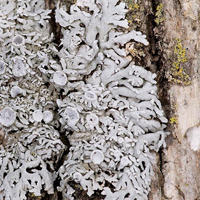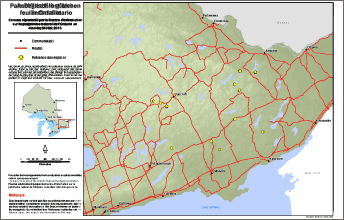Pale-bellied frost lichen
Scientific name: Physconia subpallida

Cover photo credit: Chris Lewis
Status
Endangered
“Endangered” means the species lives in the wild in Ontario but is facing imminent extinction or extirpation.
Date added to the Species at Risk in Ontario List
March 18, 2010
Read the Assessment Report
What it looks like
Pale-bellied frost lichen was named for its pale, sometimes bright white crust-like growth that resembles a dusting of frost on a tree trunk. It is usually found in wooded areas where its light colour can be eye catching against the darker surfaces on which it grows (e.g., trees, boulders).
The undersurface of Pale-bellied Frost Lichen is light in colour, in comparison to the undersurfaces of its closest relatives which can be much darker, even black.
Where it lives
Throughout its range, Pale-bellied frost lichen grows on the bark of hardwood trees such as White ash, Black walnut, and American elm. It can also be found growing on fence posts and boulders.
In Ontario, Pale-bellied frost lichen grows on Hop Hornbeam (also known as Ironwood) trunks at a height of 0.5 to 2 metres in wooded areas.
Where it’s been found in Ontario
Pale-bellied frost lichen only occurs in eastern North America.
In Canada, it is limited to southern Ontario where it is currently known from locations in Frontenac, Haliburton, Hastings, Peterborough, Lanark and Renfrew counties.
View a Larger version of this map (PDF)
What threatens it
Pale-bellied frost lichen appears to be sensitive to air pollution, particularly high levels of sulphur dioxide.
This lichen may be capable of expanding its distribution if air quality continues to improve. In addition to air pollution, land-use practices resulting in an overall loss of suitable forested habitat may have contributed to declines across Ontario.
The limited distribution of Pale-bellied frost lichen also makes it vulnerable to disturbance events such as fire and ice storms.
Action we are taking
Endangered Species and their general habitat are automatically protected
Recovery strategy
A recovery strategy advises the ministry on ways to ensure healthy numbers of the species return to Ontario.
Read the executive summary (February 18, 2011)
Read the recovery strategy (February 18, 2011)
Government response statement
A government response statement outlines the actions the government intends to take or support to help recover the species.
Read the government response statement (November 18, 2011)
Five-Year Review of Progress
A five-year review reports on progress made toward protecting and recovering a species, within five years of publishing a species’ government response statement.
Read the report on progress towards the protection and recovery of 27 species at risk, including Pale-bellied Frost Lichen (2016).
Habitat protection
A habitat regulation defines a species' habitat and many describe features (e.g., a creek, cliff, or beach), geographic boundaries or other unique characteristics.
Read the habitat summary (July 1, 2012)
Read the regulation (July 1, 2012)
Read the habitat regulatory amendment (January 1, 2014)
What you can do
Report a sighting
Report a sighting of an endangered animal or plant to the Natural Heritage Information Centre. Photographs with specific locations or mapping coordinates are always helpful.
Volunteer
Volunteer with your local nature club or provincial park to participate in surveys or stewardship work focused on species at risk.
Be a good steward
- private land owners have a very important role to play in species recovery; if you find a nesting on your land, you may be eligible for stewardship programs that support the protection and recovery of species at risk and their habitats
- as with many other rare plants and animals, Pale-bellied frost lichen is at risk due to the loss of forested areas; you can help by protecting any forests and surrounding natural vegetation on your property
Report illegal activity
- Report any illegal activity related to plants and wildlife to
1-877-TIP-SMNR (847-7667) .
Quick facts
- fewer than 100 individuals are known from the three locations in Ontario
- Pale-bellied frost lichen can reproduce sexually and asexually
- Pale-bellied frost lichen is sensitive to air pollution and could be useful as an indicator of air quality
- Pale-bellied frost lichen doesn’t use roots to access nutrients from the soil; instead, it grows on the surface of other plants (e.g., trees) or structures (e.g., rocks, fence posts) and derives nutrients from the air and rain
